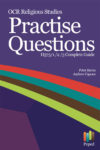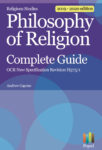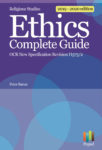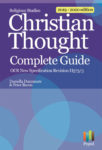Revising Natural Law
March 3, 2015
In this new series, I will be posting something every week on a key syllabus area to help with your revision.
Revising Natural Law
The aim of revision is not just to learn knowledge: we also need to practise analysis and evaluation. To this end, the four steps described here can be used to revise any theory – but I will use Natural law to illustrate the points made. We need to practise sequencing ideas so that analysis flows naturally in an exam.
Analysis is about avoiding assertions by building sequences of thought. An assertion is an unexplained statement such as “Natural law is deontological”. There are two problems with this: it tells us nothing about why or how natural law is deontological and it begs the question which is central to a good analysis “to what extent is natural law deontological?”. After all it arises out of the Greek teleological worldview, where everything has a purpose, and the purpose of humankind, says Aristotle, is to reason well to attain the end of the flourishing life (eudaimonia). So at least we need to insert the word “because”; “natural law is deontological in Aquinas’ thinking because it is based on four concepts of law, and the natural law reflects the unchanging eternal law of God”. We could then go on to explore to what extent it is an absolute deontology in the sense of natural laws admitting of no exceptions.
Step 1: Know your definitions
We need to demonstrate that we really understand terms like “teleological” and “deontological”. To do this the first thing we do is to list all the technical vocabulary contained in the syllabus in this area, and maybe add one or two of our own. So with natural law, we might add eudaimonia, phronesis, synderesis, primary precepts, secondary precepts, and the four laws of Aquinas’ thought (Natural, Divine, Eternal and Human). In the application of natural law, we might want also to define and consider apparent goods.
Having clarified the list of terms, the next step is to write then on index cards – one term per card, with the key word on one side and a fuller explanation on the other of the meaning and use of the term. This is the knowledge part, but what of understanding?
A game I like to play is to pair up and for one person to think up three technical terms. You then have to explain those terms to your partner without using the term itself – so your partner can guess the word. This ensures you are filtering the meaning through your brain. You can then swap over as your partner tries to explain three further terms.
Step 2: Practise sequencing ideas
The next step is to practise sequencing ideas. Having written the key terms down, we ask the question: where would you start an analysis? One possible place is with an assumption of the moral theory or an explanation of its worldview.
So with natural law theory Aquinas makes a colossal assumption (he doesn’t call it this!) which is that we by our very nature “do good and avoid evil” – the synderesis principle. This is a natural habit which we are born with (innate) which means we know the first principles of our reason – the primary precepts. These goals we rationally pursue to achieve the end of eudaimonia – or to attain the blessed state of being with Christ in heaven if we are a Christian.
In this way, argues Aquinas, we discover the eternal law of God and also put it into effect by obedience to the natural law.
Why do I call it an assumption? Well it is difficult to prove we by our very natures want to do good. Indeed evangelical Christains take the opposite view – that we by our very natures are born into sin and desire evil. Incidentally, St Paul seems to argue both (see Romans 1: 19-20 and compare with Romans 7).
So we could never say natural law is universal (another meaning of “absolute”) and applies everywhere at all times, if both Christian and atheist didn’t demonstrate in their own experience that the primary precepts were true and right. It can’t just be a Christian truth: it is a truth of our shared rational human nature.
And where would we end as the final telos or goal? Again, the final end is eudaimonia; there is one objective, universal goal because of what it means to be human: so we can all agree on objective grounds for human flourishing (be educated, be healthy, have a loving partner, appreciate beauty, respect the law and so on).
Step 3: Draw a mind map
Having decided on our sequence of thought and considered how we justify it, we then need to draw a physical mind map.
We place the mindmap in the centre of an A3 piece of paper, leaving plenty of space around it. We then draw a box in one corner for strengths and a box in another for weaknesses. We place some key quotes on our A3 poster, such as Aquinas’ view that “synderesis is a rational habit” or his definition of natural law as “the participation by rational creatures in the eternal law”. By the way, it’s fine to clarify the translation because Aquinas wrote in Latin and so our own translation is just as valid as any other. Also, we can translate out of academic English which often obscures the meaning by complex sentences.
Our mind map becomes a living poster which we work with. As we read more we add comments and quotes. Perhaps we look at what academics have said about natural law. It’s also wise to compare Aquinas with modern a modern natural law theory – such as John Finnis’.
The poster then goes on our wall and by the time we get to the exam day we know and understand our own sequence of thought – so when the question on natural law comes up, we reproduce the sequence quickly on a piece of scrap paper so that we can follow the line of reasoning through in our answers.
Step 4: Practise opening paragraphs
Our analytical writing needs to start the moment our pen hits the paper. No long explanations of Aquinas’ life at the University of Paris or Aristotle’s penchant for dissecting frogs. We need to go straight into the explanation of the theory (assuming the question asks us to explain natural law).
So we need to ask, where does natural law come from and how does it define the good? Rather than just describe the primary precepts (which by the way are best learnt by an acronym such as POWER – preservation of life, ordered society, worship of God and reproduction) we need to explain how they arise from the synderesis principle which Aquinas calls “the first principle of the natural law”. We need to explain how secondary precepts arise – and we need perhaps to distinguish between how Aquinas derives secondary precepts as “proximate conclusions” and therefore not absolute, but how the Roman Catholic Church, faced with the onslaught of relativism and the more situationist views of teachers in their Universities, produced documents like Veritatis Splendor (1995). This is a much harder version of natural law, because it implies the universal, objective and (unlike Aquinas) absolute nature of the secondary precepts.
In so doing we are heading towards a subtler response – and hence closer to an A grade. For we are showing care not just in how we build up a theory from its first principles, but how words which we often think have one meaning (absolute, for example) actually have a number of meanings (universal, or objective or never changing with the circumstances). It is the third meaning in brackets which is in dispute, because Aquinas emphasises that secondary precepts can change with circumstances, whereas the recent Catholic interpretations (Humanae Vitae, 1967, Veritiatis Splendor, 1995) seem to imply that applications such as “no contraception” are somehow cast in stone.






0 Comments